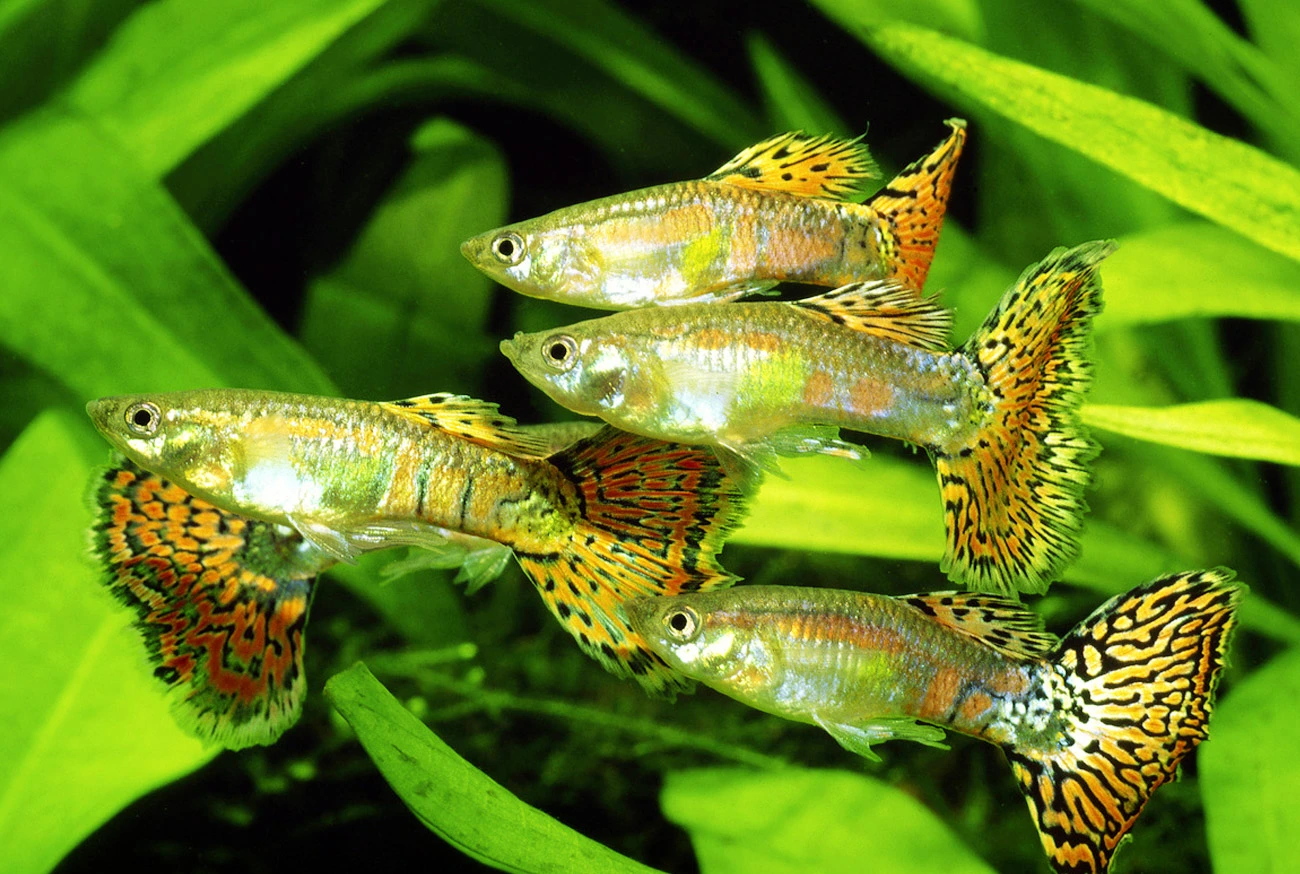In this comprehensive guide, you will learn everything about guppy care, from feeding and breeding to tips for keeping your aquarium healthy. Ready to dive into the world of this enchanting fish?
Characteristics of the guppies
The guppy, scientifically known as Poecilia reticulata, originates from South and Central America, inhabiting freshwater rivers and lakes. This small fish is renowned for its variety of colors and being a livebearer, meaning it gives birth to fully formed fry without the need for eggs.
- Size: Males measure between 2 and 4 cm, while females can reach up to 6 cm.
- Vibrant colors: Males display a wide range of colors and flamboyant tails, while females are more subdued.
- Lifespan: They live between 2 and 3 years, depending on aquarium conditions.
These characteristics make the guppy ideal for anyone looking for a beautiful and easy-to-maintain aquarium.
How to set up the perfect aquarium for guppies
To ensure the health and well-being of your guppies, creating the right environment is essential. Here are some tips:
Tank size and shape
Although small, guppies need space to swim. A 40-liter tank is sufficient for a small group. If you plan to breed guppies, consider a larger tank to accommodate the fry.
Ideal water conditions
Water quality is crucial. Maintain a temperature between 24°C and 28°C, a pH level of 7.0 to 7.8, and use an efficient filter to prevent waste buildup.
Decoration
Add aquatic plants such as Java moss and elodea, which help oxygenate the water and provide hiding spots for fry. Decorative stones and driftwood also create a more natural and welcoming environment.

Feeding: The secret to healthy guppies
A balanced diet is essential for the health and vibrant colors of guppies. They are omnivores and enjoy a varied diet.
- Commercial food: Choose a high-quality tropical fish food rich in protein and nutrients.
- Live food: Brine shrimp and mosquito larvae are excellent for stimulating natural hunting instincts.
- Vegetables: Small pieces of cooked spinach or peas complement their diet.
Tip: Feed your guppies twice a day in small portions that can be consumed within two minutes.
Breeding: A fascinating spectacle
Guppy breeding is one of the most interesting aspects of this species. They are known to be extremely prolific. Learn how to breed guppies successfully:
The mating process
The males court the females by displaying their colorful tails. After mating, the female carries the fry for about 28 days before giving birth.
Separating the fry
As soon as the fry are born, it is important to separate them from the adults to avoid predation. A separate tank or a floating breeding box is ideal.
How to care for your guppy's health
Although hardy, guppies can be affected by diseases such as ich and fungi. Prevention is always better than cure:
- Keep the water clean and free from ammonia.
- Avoid overcrowding the tank.
- Watch for signs of stress, such as erratic swimming or loss of appetite.
If you notice anything unusual, isolate the affected fish and treat the tank with specific medications.
Why is the guppy perfect for beginners?
If you are starting in the world of aquariums, the guppy is a fantastic choice. They are easy to care for, resilient, and do not require sophisticated equipment. Additionally, their natural reproduction allows you to observe the full life cycle in your tank.
Fun facts about guppies
- Natural mosquito control: Guppies are known for eating mosquito larvae, helping with pest control.
- Genetic diversity: There are hundreds of guppy varieties with unique patterns and colors.
- Worldwide popularity: The guppy is one of the most studied and bred fish in captivity worldwide.
The fish every aquarist should know
The guppy is much more than an ornamental fish. It is a vibrant and lively companion that transforms any tank into a true spectacle. Its colors, personality, and ease of care make it ideal for all experience levels.
Whether to decorate your home or explore the fascinating world of fishkeeping, the guppy is the perfect choice. Now that you know everything about them, share this article with your friends on social media and inspire others to discover this amazing fish!
Most frequently asked questions about guppies
How to keep a guppy happy?
To keep a guppy happy, provide a clean and well-decorated tank with aquatic plants and enough space for free swimming. Maintain the water temperature between 24°C and 28°C, with a neutral or slightly alkaline pH. Additionally, offer a varied diet, including specific fish food, live foods, and vegetables, to ensure health and vibrant colors.
How to care for a guppy?
Caring for a guppy is simple. Use a suitable tank with a filter and heater to keep the water clean and at the right temperature. Feed them small portions twice a day, ensuring a balanced diet. Perform partial water changes weekly and monitor for signs of disease, such as white spots or unusual behavior.
How many guppies per liter of water?
It is recommended to keep one guppy for every 4 to 5 liters of water, ensuring enough swimming space and a healthy environment. In a 40-liter tank, for example, you can comfortably house between 8 and 10 guppies, depending on the amount of decoration and plants.
How long does it take for a guppy to grow?
Guppies reach adulthood between 3 and 6 months, depending on care conditions. A nutrient-rich diet, clean and stable water, and adequate space contribute to quick and healthy growth.
Was the guppy introduced in Brazil to combat dengue and malaria?
Yes, the guppy was introduced in Brazil as a biological control measure to combat dengue and malaria. They are efficient in consuming mosquito larvae, helping to reduce the proliferation of these insects in risk areas.

















Add comment